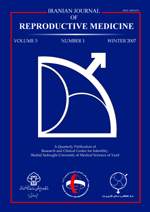
|
International Journal of Reproductive BioMedicine
Research and Clinical Center for Infertility, Shahid Sadoughi University of Medical Sciences of Yazd
ISSN: 1680-6433
EISSN: 1680-6433
Vol. 17, No. 10, 2019, pp. 685-708
|
 Bioline Code: rm19073
Bioline Code: rm19073
Full paper language: English
Document type: Review Article
Document available free of charge
|
|
|
International Journal of Reproductive BioMedicine, Vol. 17, No. 10, 2019, pp. 685-708
| en |
The prevalence of hypovitaminosis D and its risk factors in pregnant women and their newborns in the Middle East: A systematic review
Hajizadeh, Shayesteh; Shary, Judy Rankin; Reed, Susan Gayle & Wagner, Carol Lynn
Abstract
Background: Pregnant women and newborns are at risk for vitamin D deficiency (VDD). Also, poor health outcomes for pregnant women with VDD are reported in the published literature.
Objective: The aim of this systematic review was to estimate the prevalence of hypovitaminosis D and the associated risk factors for hypovitaminosis D in Middle Eastern pregnant women and their newborns.
Materials and Methods: The international electronic databases PubMed and Scopus for the years 2000-2017 were utilized to identify studies of vitamin D status for pregnant women and newborns in the Middle East. Of the 1,785 reports identified, 1,734 met exclusion criteria and 51 studies were included for this review.
Results: The prevalence of circulating 25-hydroxyvitamin D (25(OH)D) < 50nmol/L as a marker of vitamin D status in pregnant women and their newborns was between 24.5-98% and 22-100%, respectively. The prevalence of 25(OH) D < 25 nmol/L in pregnant women and their newborns was over a wide range between 16.7-80% and 22-82%, respectively. Predictors for low maternal and neonatal 25(OH)D concentrations included decreased vitamin D synthesis due to reduced exposure to sunlight and decreased nutritional intake of vitamin D. A predictor of low neonatal 25(OH)D concentrations included maternal vitamin D status and the correlation between vitamin D concentrations in maternal and cord blood.
Conclusion: The high prevalence of VDD in the pregnant women of the Middle East underscores the necessity of implementing national prevention and intervention strategies. A clear policy for clinicians and healthcare workers is needed for screening and maintaining sufficient vitamin D status during pregnancy.
Keywords
Vitamin D; Pregnancy; Newborns; Cord blood; Middle East.
|
| |
© Copyright 2019 - Shayesteh Hajizadeh et al.
Alternative site location: http://www.ijrm.ir
|
|
